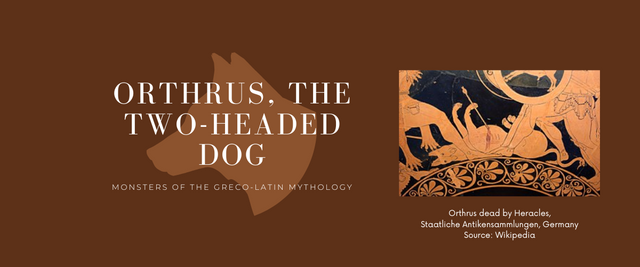Author's note: The following post was published previously in Spanish language in Blurt, in February 2nd, 2023.
In the past entry was broadly explored who was Geryon, a giant who had the peculiarity of possessing three bodies jointed at the hip. This character appeared at the first time in the myth of Heracles; the heroe had the mission of taking Geryon's vast cattle without asking or paying for it, coming to confront the giant, who came when he found out about the death of the shepherd Eurytion and his loyal animal companion, Orthrus, of whom today we'll explain.
Who was Orthrus?
According to Pierre Grimal (1981), Orthrus, also named in some versions like Orthus, was the son of Typhon and Echidna, both monstruous beings. From the paternal side, he was the grandson of the primordial divinities Gaia and Tartarus; from the maternal side, he was the grandson of the marine god Phorcys and the monster Ceto. He appears mentioned for the first time in Hesiod's Theogony (2000), who describes it as Echidna and Typhon's first child; according to the author, Echidna hands him over to Geryon, the three-bodied giant, who entrusts him with the care of his cattle along with Eurytion.
An interesting detail mentioned by Christine Harrauer and Herbert Hunger (2008) regarding its appearance is that its current description, the two-headed dog, appears in later versions of the myth of Heracles, who kills it with his bare hands.
The offspring of Orthrus
Regarding his descendants, Constantino Falcón Martínez, Emilio Fernández-Galiano and Raquel López Melero (1989) mention that he had three children born from his union with Echidna: the Chimera, the Sphinx of Thebes and the Nemean Lion.
Consulted sources
- Falcón Martínez, Constantino; Fernández-Galiano, Emilio; y López Melero, Raquel. 1989. Diccionario de mitología clásica. Tomo II. México. Alianza Editorial.
- Grimal, Pierre. 1981. Diccionario de mitología griega y romana. España. Paidós. (English version: The Penguin Dictionary of Classical Mythology, 1992)
- Harrauer, Christine, y Hunger, Herbert. 2008. Diccionario de mitología griega y romana. España. Herder.
- Hesíodo. 2000. Teogonía. Trabajos y días. Escudo. Certamen. México. Alianza Editorial. (English version: Theogony and Works and Days [Oxford World's Classics])
** Banner elaborated with Canva. Source of the image: Wikipedia.